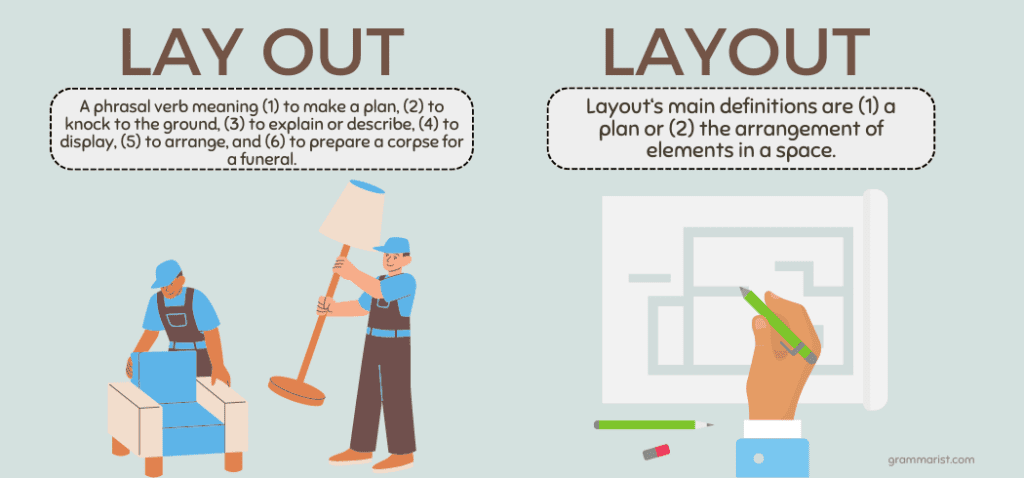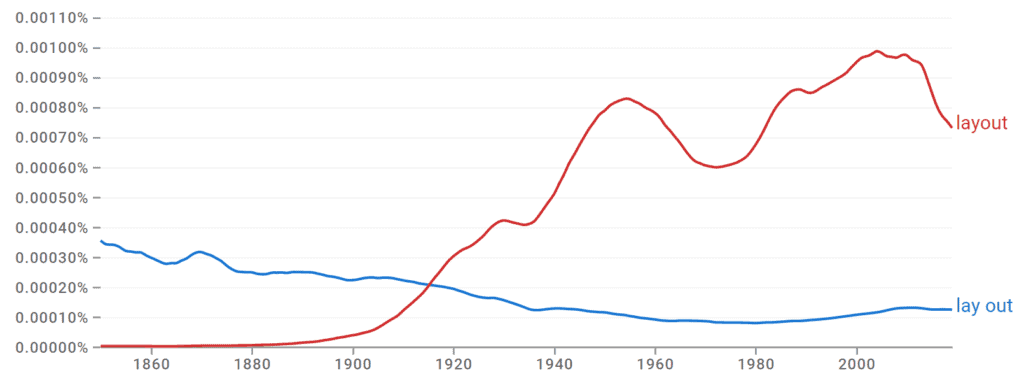Nothing is more confusing when learning a language than words or phrases that sound the same but are used differently in both speech and writing.
Most phrasal verbs (a verb that combines a verb with a preposition or adverb) also have a one-word form. Even though they are similar to one another in definition, their part of speech dictates very different uses.
Lay out and layout are perfect examples of this. Choosing between the two when writing has frustrated writers for years and is particularly frustrating to language learners. But, if you can remember a few simple rules, it makes your writing much clearer and more concise for your audience to understand.
What’s the Difference Between Lay Out and Layout?

Lay out, as explained above, is a phrasal verb consisting of more than one word to form an act of making a plan, explaining, arranging, or preparing. Layout is a one-word, corresponding form that can function as both a noun and an adjective but never as a verb.
What Does Lay Out Mean?
Lay out is a phrasal verb meaning (1) to make a plan, (2) to knock to the ground, (3) to explain or describe, (4) to display, (5) to arrange, and (6) to prepare a corpse for a funeral.
Laid out is the past tense of the phrase. You may see layed out used, but this is incorrect and should be avoided.
For example:
- When making pie, it is important to lay out all your ingredients in advance.
- The document lays out the principles clearly.
- Please lay out the clean sheets so I can turn these beds over quickly.
- The flower arrangements were laid out across the sideboard, displaying each quite beautifully.
- I spent a summer interning at a funeral home, but I will never get used to the sight of a body laid out after death.
- She laid him out with an uppercut to the chin.
What Does Layout Mean?
Layout‘s main definitions are (1) a plan or (2) the arrangement of elements in a space.
For example:
- I need you to approve one of the interior decorator’s layouts before the architect shows up to the meeting.
- The layout of the new pool only needed the contractor’s approval before the ground could be broken.
- Printing presses used to depend upon a new layout for each page before printing hundreds of copies that were put in order after drying.
Lay Out vs. Layout: Origins of Use

Layout, meaning configuration or arrangement, was adapted in the mid-19th century from the verbal phrase lay out. Its use as a means to describe a rough design or draft of a printing job is from the early 20th century.
The verbal phrase lay out originated in the 1400s to express an “exposure to view, show, or set forth.” By the late 1500s, lay out was being used as a means to describe the preparation of a corpse for burial.
Let’s Review
Lay out is a verb phrase that can mean multiple things in reference to the action of preparation, arrangement, or knocking a person to the ground. Layout is a related word that serves as a noun to describe the plan or arrangement of something.

Comments are closed.